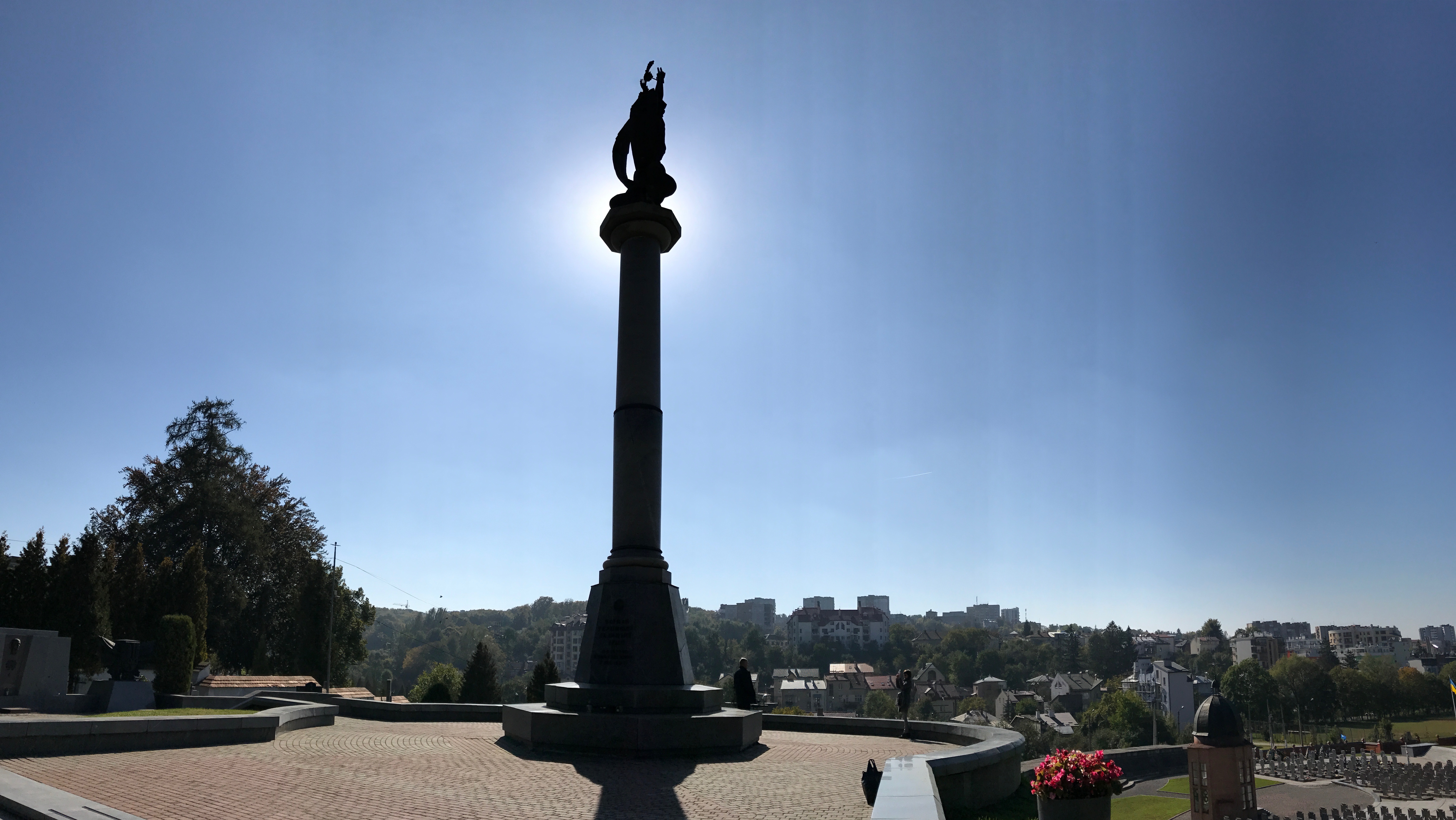Tug-of-War Between East and West: Lychakiv and The Geo-Politics of Memory
By Paige Foley
Established in 1786 during Lviv’s Habsburg era, the Lychakiv Cemetery was originally a site wherein only the region’s upper class and intelligentsia would find their final resting place. By the 1850s, Lychakiv became the central cemetery of the city, utilized by all the Christian sects of the city. During the centuries that followed, and throughout the changing political and cultural evolution of the region, this ‘city of the dead’ would expand not only geographically- to encompass the 40 hectares it does today, but also expand the demographic of its ‘citizens’. From Lviv’s Austro-Hungarian period, the Polish interwar period, the Soviet period and up until Ukraine’s independence, the layers of the city’s history are evident in Lychakiv, which today represents one of the most impressive necropolises in Europe. Lychakiv Cemtery was given the status of museum in 1991.
Podcast

Lviv is considered by many to be a city of paradoxes.* With the achievement of independence from the Soviet Union still relatively recent in its timeline, and even more recent struggles to relinquish its very ‘East-ness’ as witnessed in the attempts to join the European Union, a tug-of-war between East and West seems to encapsulate both Ukraine’s past and present.
As we know, Ukraine is currently in the midst of a war on its own soil, which has been ongoing since Russia’s military intervention in Eastern Ukraine in 2014. Though the city of Lviv itself is not a warzone, evidence of the struggle in the East was nonetheless present during our time there, as could be seen in the significant presence of uniformed men and women throughout the city. Indeed their presence in Lviv seems indicative that Ukrainians in the West are not passively waiting for the struggle to end with bated breath; instead, Lviv has become a site of intensive training for Ukrainian military personnel who are, not for the first time in their history, adamant on expelling the Eastern threat and reclaiming their sovereignty.
In the battle against their hegemonic neighbour, Ukraine is not alone. Against the Eastern threat, the Western world has come to Ukraine’s aid; countries such as the United States, Canada and the United Kingdom have lent training assistance to Ukraine’s military operation, also referred to as ‘ATO’ or ‘Anti-Terrorist Operation,’ staunch that, “the values of freedom and democracy cannot be traded.” To date, it is estimated that nearly 3,000 Ukrainian participants have died in the ATO, many of whom are buried in Lviv’s Lychakiv Cemetery.
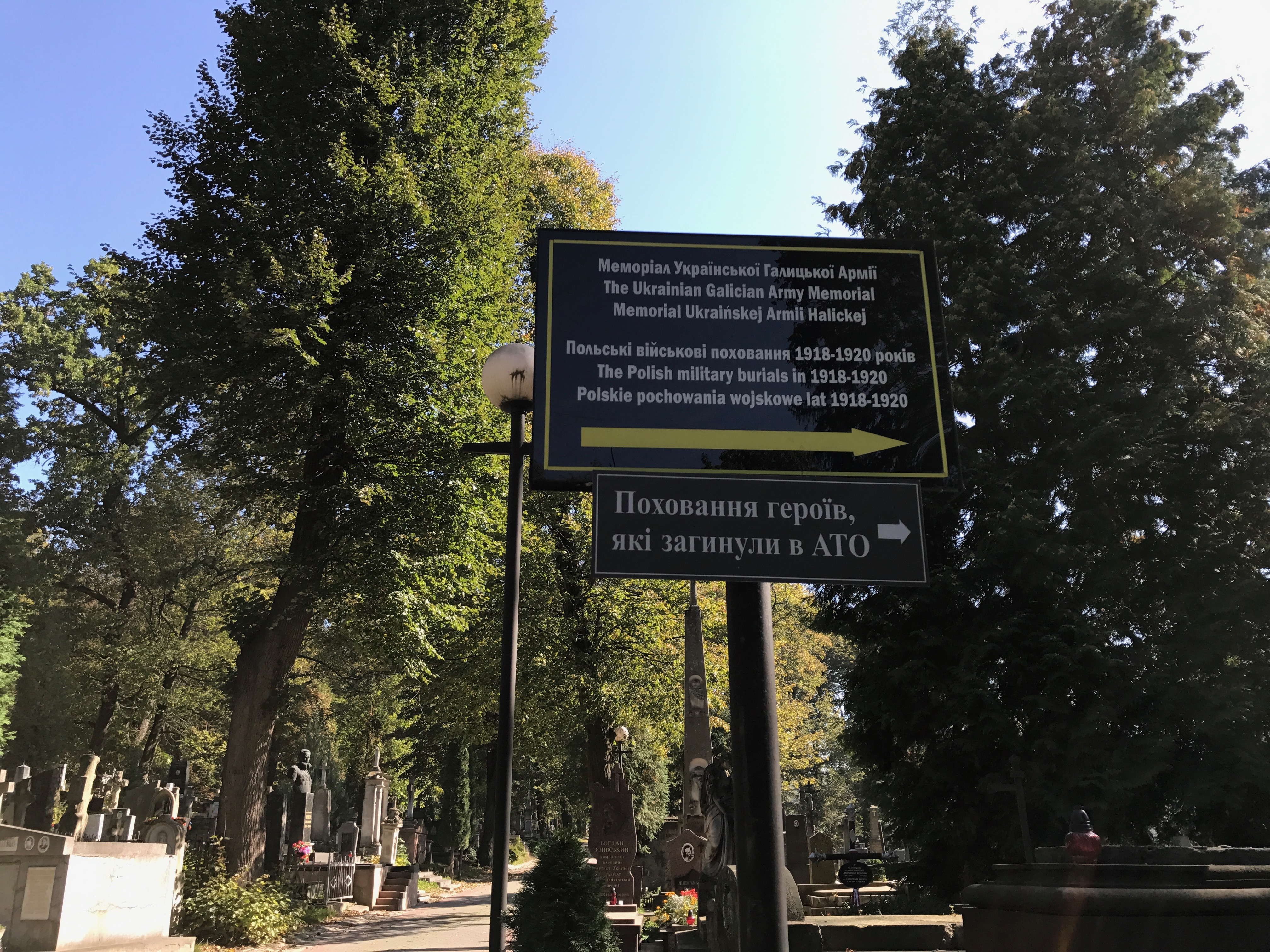
Of the many sites we were given to choose from for a site analysis within Lviv, I decided on Lychakiv more-or-less immediately without having done a great deal of background research; in the end, my choice of Lychakiv can be chalked up to a morbid curiosity for all things ‘spooky,’ as well as my typically-millennial nihilist sense of humour. That being said, the more research I conducted on Lviv’s complex past, I became increasingly interested in the ways in which conflicting ideologies and contested memories have been reconciled within Lychakiv. Buried within Lychakiv, after all, are the war dead of Poles, Ukrainians and Soviets alike; The Lviv Defenders’ Cemetery, for example, is a place of remembrance for the Polish youth that lost their lives in the calamities of the Polish-Ukrainian War (1918-1919), as well as the Polish-Soviet War (1919-1921); the Ukrainian National Army Memorial contains soldiers from a variety of periods- including those of the SS-Division Galicia, a division of Hitler’s Waffen-SS focused on the Eastern Front. And yet, also present just beyond the main cemetery is the Field of Mars, containing the burials of 3600 soldiers of Stalin’s Red Army, who fought, amongst others, against the SS Galicia.
With this in mind, I became particularly fascinated by the ways in which cemeteries are, at once, testaments both to the past as well as the present. In contrast to many other historic cemeteries, the burial plots within Lychakiv are not rented out in incremental terms, but are permanent; and yet, at the same time, the cemetery is continually evolving, as new burials, monuments and memorials are ever being added.
Lychakiv’s paradigm, it seems, is one of both permanence and change.
Particularly given Ukraine’s still somewhat recent status of independence, I was inspired to understand the devices through which Lychakiv can be seen to affirm Ukrainian identities in the present by absolving Lviv of its contested past; and, moreover, the devices through which the cemetery, as a tourist destination, can be considered to attract Western empathy through the damnation of notions of ‘Eastness’ in what could be considered the geo-politics of memory.[1]

Katherine Verdery, in her excellent book The Political Lives of Dead Bodies, has suggested that cemeteries are imbued with the ‘politics of legitimation;’[2] this means that political regimes, in acknowledging the permanence of dead bodies, often use cemeteries to permeate civil society with the sacredness of their ideology for, in theory, an indefinite amount of time. Conversely, the same effect can be achieved by erasing the corporeal presence of an ideological predecessor within the cemetery (…seen in this light, it would seem that the term ‘body politic’ is, in fact, a double entendre.).
As discussed briefly within the preceding podcast, this has happened several times over the course of Lychakiv’s history. For instance, during the Soviet era, many Austro-Hungarian burials within Lychakiv were removed and subsequently replaced with burials of Stalin’s Red Army. Verdery therefore argues that the manipulation of cemeteries can be regarded as a powerful influencer of narratives of history, capable of “reordering meaningful worlds.”[3] The post-Soviet era was not wholly different in realizing the ideological dimension of Lychakiv and consequently acting upon it; within independent Ukraine, it became necessary to delegitimize Soviet ideology in order to “persuade Western audiences to contribute to the aid and investment essential to reconstruction.”[4] As discussed within the podcast, one can view the 1994 and 1999 burials of NKVD victims’ remains within the Field of Mars as an act of de-legitimation in this respect.
Similar to Lychakiv’s changes in the immediate post-Soviet era, Ukraine is at present, perhaps more than ever, in need of the West in the battle against Russian terror; and once more, Lychakiv can be seen to play a role. Despite the war, Lviv maintains a status as a prominent tourist destination for peoples from many origins, and Lychakiv itself ranks at #6 as ‘Things to Do,’ within the city.
With this in mind, I’ve chosen to analyze the ways in which the cemetery can be seen to act upon its visitors in the following specific regions of Lychakiv.
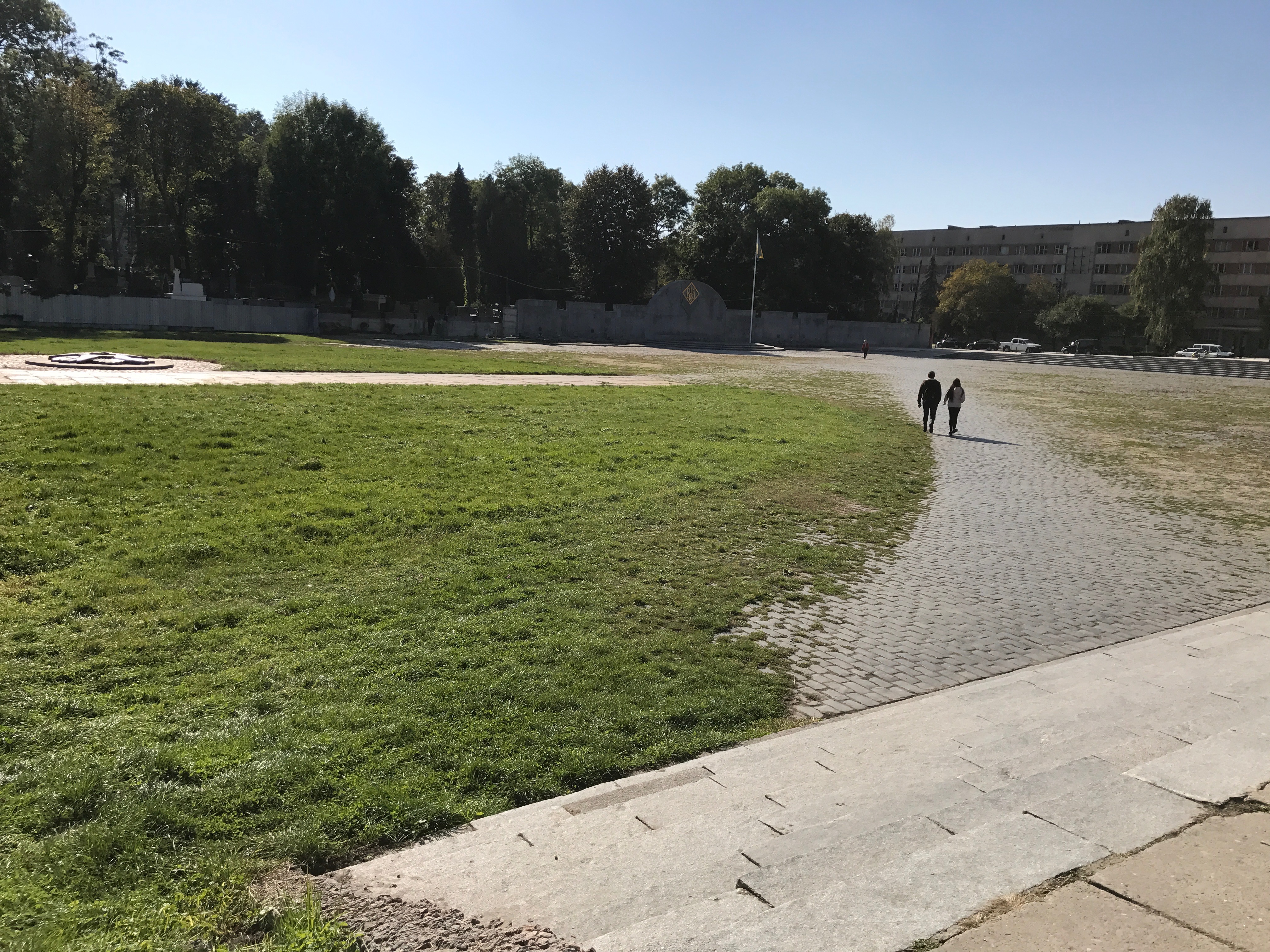
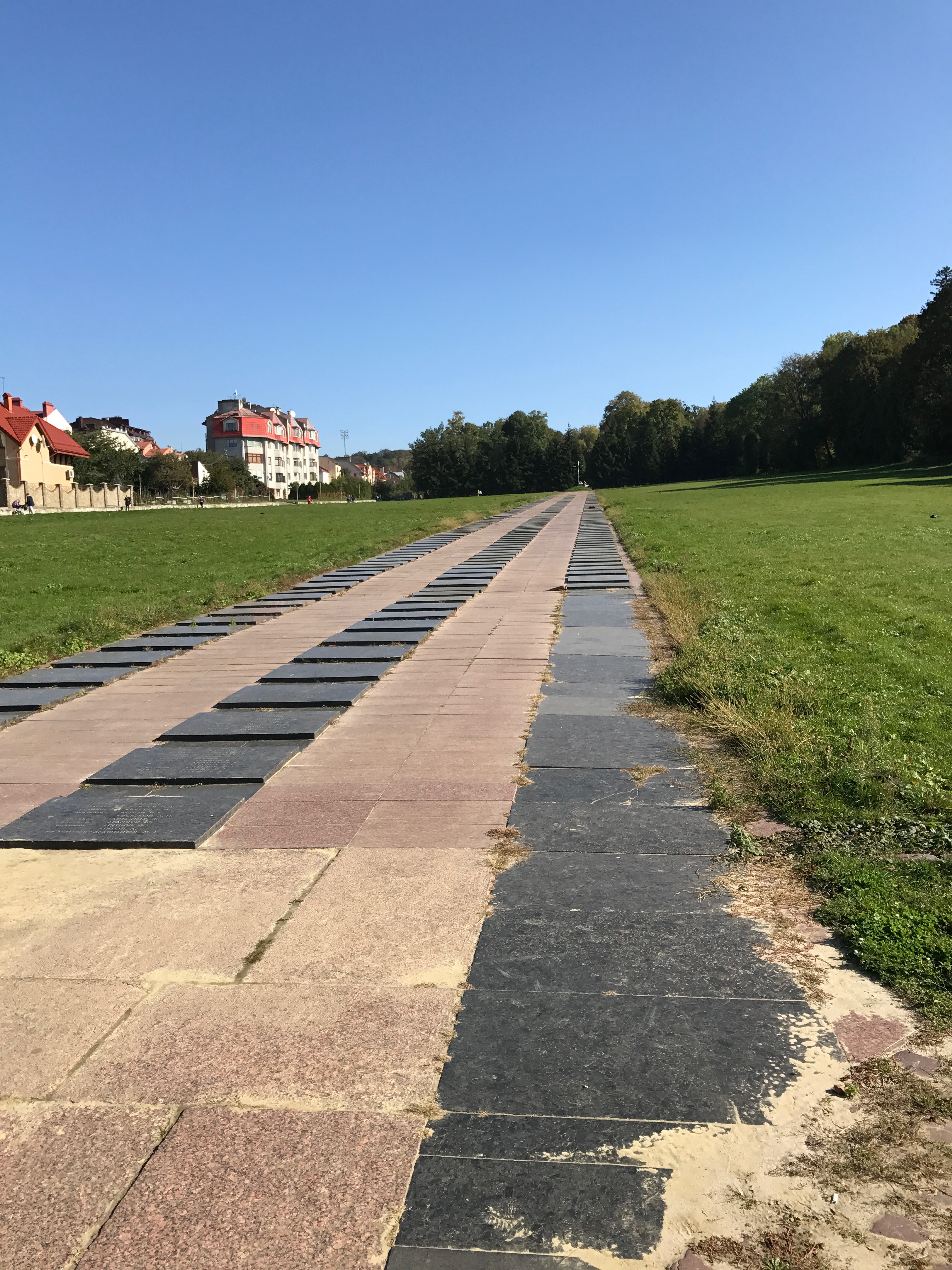
One can regard Lychakiv as playing dual roles for a dual demographic- at least that is my own personal diagnosis. The Field of Mars (as discussed more within the podcast above), outside the main cemetery gates, seemed to be more influential within local life than anything else. Reminiscent of a park, the burials of several thousand Red Army soldiers are not an overwhelming visual in and of themselves, as they are not accompanied by vertical headstones, or striking monuments of any kind. While I was there, I saw several people walking their dogs and chatting on benches with little regard for the burials surrounding them. In essence, the Field of Mars is just that- a field, and a green space wherein locals can congregate.
In contrast to this, the main cemetery exists adjacent to the Field of Mars, encapsulated within a gate. Visitors to the main cemetery are required to pay a (small) fee to enter, and another (small) fee to receive a map and guide of the cemetery. While I noticed very few people within the cemetery while I was there, I did happen across two large two groups on my way out. My initial conclusion, therefore, is that the main cemetery is not predominantly geared towards local Ukrainians, but rather towards tourists. This was confirmed in my discussion with a member of Lychakiv’s research department; according to whom, many tourists originate from countries wherein Ukrainians settled during the two waves of diaspora in the twentieth century, such as Australia, the United States and Canada. Oftentimes, these tourists are motivated to visit Lychakiv due to an interest in discovering their roots. Beyond this, it was conveyed to me that the visitor demographic includes Western Europeans from Germany as well as Italy; and, of course, due to Lviv’s complex past as a border city, Poles are also among this demographic.
With this in mind, it seems that Lychakiv does in fact have a largely Western tourist demographic. But what histories are these tourists exposed to? And to what extent does the map or the guided tour reinforce certain historical narratives?
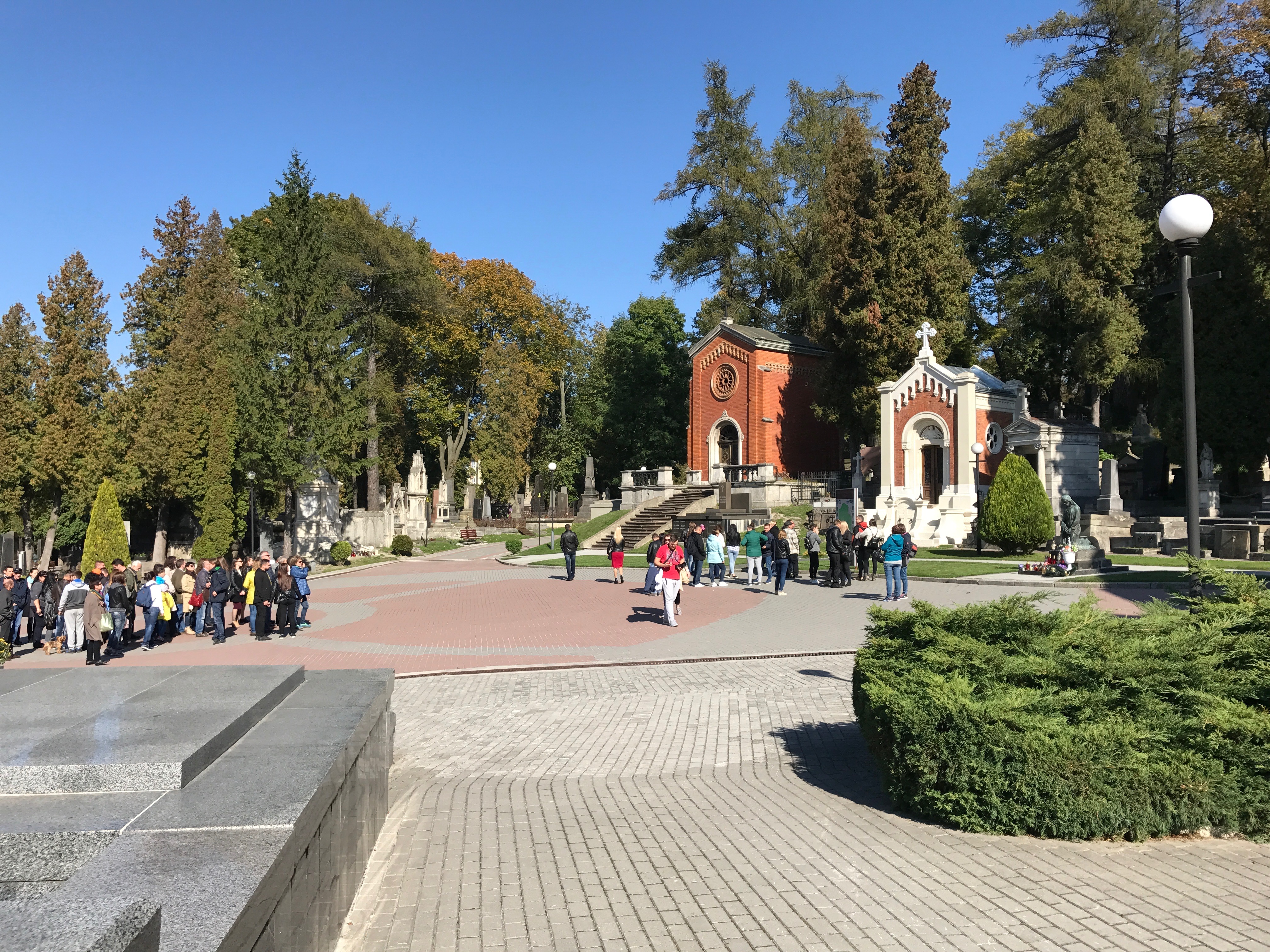
Lychakiv is, to be quite frank, a beast.
Its immense size makes it almost impossible for the average tourist to see everything or, perhaps more accurately, everyone. While I had, prior to my visit, achieved an understanding of Lviv’s contested past insofar as the Second World War, and the tangible remains of that past within Lychakiv, it is unlikely that the average tourist is going to make a beeline for these burials; and indeed, these initial thoughts were confirmed by the staff member I spoke with, who asserted that, by far, the most beloved and most visited burial at Lychakiv is that of cultural figure Ivan Franko. The pre-eminence of Lychakiv’s cultural history was further reinforced on our extremely awkward tour of the cemetery, given by the same staff member, wherein my previous requests to view only the military burials were basically, if not entirely, dismissed. Instead, our class was treated to what felt like a lifetime discussing motifs on the graves of apparently famous people I’d never heard of.
Considering the notion that our guide had been made well aware of my desire to visit the military burials and chose instead to focus on cultural figures, it seems plausible that in the post-Soviet era, there is a desire to foster a collective memory based on positive,[5] identity-affirming pasts, i.e. the cultural past, rather than to re-hash Lviv’s contested pasts. Eleonara Narvselius reflects on the sacred role that the cultural past has come to play within an independent Ukraine, particularly within Lviv, arguing that the immediate post-Soviet period saw the beginnings of a new national project; as “the closest city to Europe,” within the country, Lviv was mandated to become a model as the “least Sovietized” Ukrainian city, with a national and international reputation as the, “principle cultural centre of independent Ukraine.”[6]
When one considers the prevalence with which we as a class heard the name Ivan Franko in those short few days, it seems clear that this national project is still a focus within the city of Lviv.
That being said, there is one military burial that Lychakiv recommends to its visitors, and it is precisely its location wherein the problematic lies. Based on my conversation with the aforementioned staff member, the war in Eastern Ukraine has seen the ATO burials trump Ivan Franko as the most visited element of the cemetery. Located within the North-Eastern part of the cemetery, evidence of the ATO’s transcendent status can be seen in the masses of flowers, candles and Ukrainian flags which adorn burials as recent as several months ago- evidence of visitors who have come to pay respect to those who died fighting against what is perceived as Russian terror.

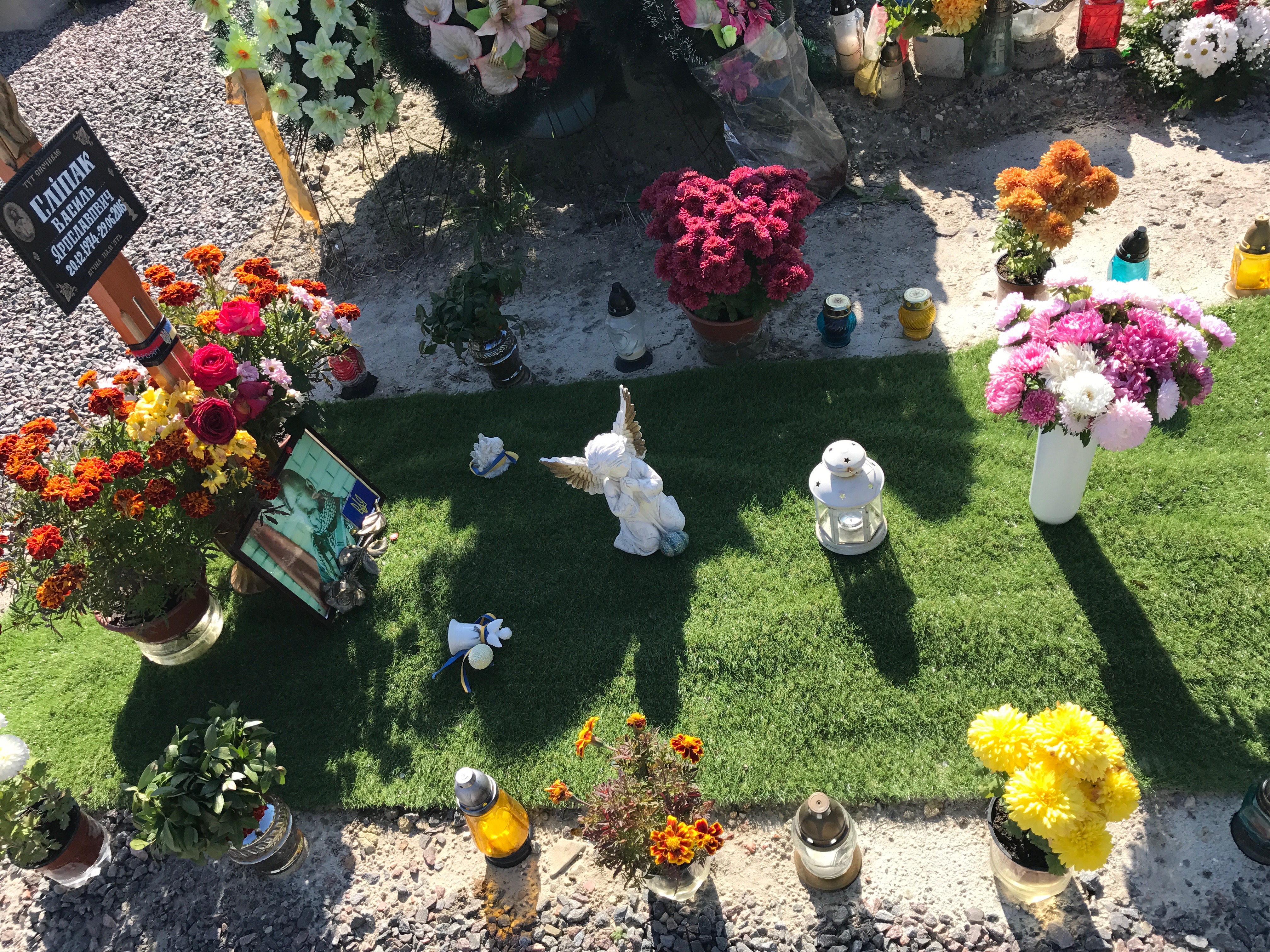
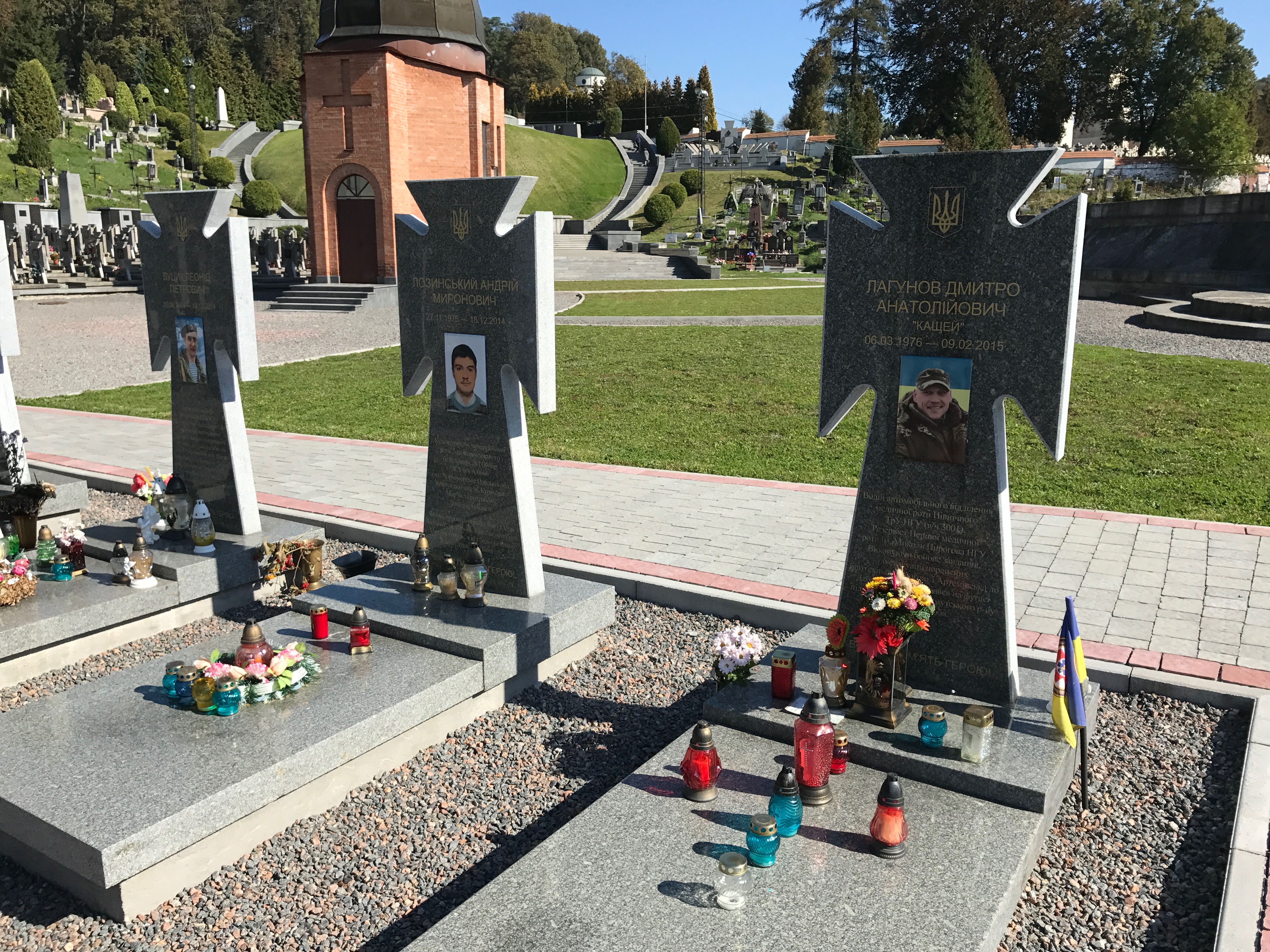
The ATO burials are adorned in a variety of Christian imagery including vestiges of the Virgin Mary, headstones engraved with motifs of Jesus on the cross, and accompanying bible passages. Herein lies the most obvious rejection of Ukraine’s Soviet past and what also might be seen as attempts to attract the empathy of the West. As discussed within the podcast, one of the primary cornerstones of Soviet ideology was the promotion of secular values and the unyielding rejection of religious authority. Viewed in this way, the excess of Christian imagery can be seen as evidence of Ukraine’s break with their Soviet past in favour of Western values. Verdery reinforces this notion, stating that, “the use of religious idioms may also be part of remaking the world as a moral place.”[7]
If the motifs on the ATO burials can be seen as the legitimation of the moral struggle of Ukraine in the fight against Russian aggression, it is extremely noteworthy that these burials are adjacent to the burials of the SS-Division Galicia and the Ukrainian Insurgent Army, both of whom defied Soviet supremacy during the Second World War but nonetheless maintain a contested legacy for complicity in the Nazi agenda and mass violence against the Poles.[8] To me, the placement of ATO participants near these more contested burials can be seen as an attempt to absolve the crimes of their ‘predecessors’- which is reinforced in the absence of victims (ie. Jewish burials) and the prevalence of religious motifs.

Collectively, my interpretation of Lychakiv as evidence of the geo-politics of memory is reliant on three primary features. First, the fact that the Soviet burials are not within the gates of the main cemetery, which might symbolically represent the de-canonization of the Soviet past; second, the focus on a rich cultural heritage- as represented within the suggested route provided by the map as well as the guided tour- can be seen as evidence of rebellion against the perceptively grey cultural topography of the Soviet era; and finally, dowsing the contested Ukrainian past with moral distinction, by employing religious motifs and inserting victims of Russian terror alongside the ‘victims’ of Soviet terror, can be interpreted as a manner of absolving the contested past through the heroism and martyrdom of the present.
*Read Lviv: City of Paradoxes by Michael Driebergen, Kees van Ruyven and Ruud Meij for more on this.
[1] Eleonora Narvselius, Ukrainian Intelligentsia in Post-Soviet L’viv: Narratives, Identity, and Power (Lexington, 2012), 337.
[2] Katherine Verdery, The Political Lives of Dead Bodies: Reburial and Postsocialist Change (Columbia University Press, 2000), 37.
[3] Ibid, 51-52.
[4] Ibid, 52.
[5] Narvselius, Ukrainian Intelligentsia in Post-Soviet L’viv: Narratives, Identity, and Power, 241.
[6] Ibid, 242.
[7] Verdery, The Political Lives of Dead Bodies: Reburial and Postsocialist Change, 38.
[8] Michael Driebergen, “Lviv: A Complex and Dramatic History,” in Lviv: A City of Paradoxes ed. Michael Driebergen, Kees van Ruyven and Ruud Meij (Wijdemeer Louw Dijkstra, 2014), 54.
